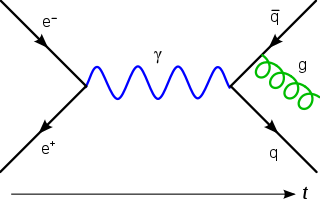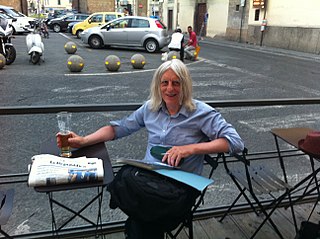Related Research Articles
A conformal field theory (CFT) is a quantum field theory that is invariant under conformal transformations. In two dimensions, there is an infinite-dimensional algebra of local conformal transformations, and conformal field theories can sometimes be exactly solved or classified.
In theoretical physics, the anti-de Sitter/conformal field theory correspondence is a conjectured relationship between two kinds of physical theories. On one side are anti-de Sitter spaces (AdS) that are used in theories of quantum gravity, formulated in terms of string theory or M-theory. On the other side of the correspondence are conformal field theories (CFT) that are quantum field theories, including theories similar to the Yang–Mills theories that describe elementary particles.

Alexander Markovich Polyakov is a Russian theoretical physicist, formerly at the Landau Institute in Moscow and, since 1989, at Princeton University, where he is the Joseph Henry Professor of Physics Emeritus.
Critical exponents describe the behavior of physical quantities near continuous phase transitions. It is believed, though not proven, that they are universal, i.e. they do not depend on the details of the physical system, but only on some of its general features. For instance, for ferromagnetic systems at thermal equilibrium, the critical exponents depend only on:

In particle physics, the history of quantum field theory starts with its creation by Paul Dirac, when he attempted to quantize the electromagnetic field in the late 1920s. Major advances in the theory were made in the 1940s and 1950s, leading to the introduction of renormalized quantum electrodynamics (QED). The field theory behind QED was so accurate and successful in predictions that efforts were made to apply the same basic concepts for the other forces of nature. Beginning in 1954, the parallel was found by way of gauge theory, leading by the late 1970s, to quantum field models of strong nuclear force and weak nuclear force, united in the modern Standard Model of particle physics.
In theoretical physics, a primary field, also called a primary operator, or simply a primary, is a local operator in a conformal field theory which is annihilated by the part of the conformal algebra consisting of the lowering generators. From the representation theory point of view, a primary is the lowest dimension operator in a given representation of the conformal algebra. All other operators in a representation are called descendants; they can be obtained by acting on the primary with the raising generators.
In quantum field theory the C-theorem states that there exists a positive real function, , depending on the coupling constants of the quantum field theory considered, , and on the energy scale, , which has the following properties:
The non-critical string theory describes the relativistic string without enforcing the critical dimension. Although this allows the construction of a string theory in 4 spacetime dimensions, such a theory usually does not describe a Lorentz invariant background. However, there are recent developments which make possible Lorentz invariant quantization of string theory in 4-dimensional Minkowski space-time.
Sergio Ferrara is an Italian physicist working on theoretical physics of elementary particles and mathematical physics. He is renowned for the discovery of theories introducing supersymmetry as a symmetry of elementary particles and of supergravity, the first significant extension of Einstein's general relativity, based on the principle of "local supersymmetry". He is an emeritus staff member at CERN and a professor emeritus at the University of California, Los Angeles.
Alexander Borisovich Zamolodchikov is a Russian physicist, known for his contributions to conformal field theory, statistical mechanics, string theory and condensed matter physics.
Alexander "Sasha" Abramovich Belavin is a Russian physicist, known for his contributions to string theory.
This article lists the critical exponents of the ferromagnetic transition in the Ising model. In statistical physics, the Ising model is the simplest system exhibiting a continuous phase transition with a scalar order parameter and symmetry. The critical exponents of the transition are universal values and characterize the singular properties of physical quantities. The ferromagnetic transition of the Ising model establishes an important universality class, which contains a variety of phase transitions as different as ferromagnetism close to the Curie point and critical opalescence of liquid near its critical point.
In physics, Liouville field theory is a two-dimensional conformal field theory whose classical equation of motion is a generalization of Liouville's equation.

Alexander Arkadyevich Migdal is a Russian-American mathematical and theoretical physicist currently working at the Institute for Advanced Study in Princeton, New Jersey.

Riccardo Rattazzi is an Italian theoretical physicist and a professor at the École Polytechnique Fédérale de Lausanne. His main research interests are in physics beyond the Standard Model and in cosmology.
A two-dimensional conformal field theory is a quantum field theory on a Euclidean two-dimensional space, that is invariant under local conformal transformations.

Hugh Osborn is a British theoretical high-energy physicist and a professor emeritus at the University of Cambridge, Department of Applied Mathematics and Theoretical Physics. He is known for his work on Conformal Field Theory and Quantum Field Theory.
Vyacheslav Rychkov is a Russian-Italian-French theoretical physicist and mathematician.
Zohar Komargodski is an Israeli theoretical physicist who works on quantum field theory, including conformal field theories, gauge theories and supersymmetry.
André LeClair is a Canadian-American physicist and academic. He is a Professor at the Cornell University.
References
- ↑ "Using the 'Bootstrap,' Physicists Uncover Geometry of Theory Space | Quanta Magazine". Quanta Magazine. Retrieved 2018-01-03.
- ↑ Polyakov, A. M. (1974). "Nonhamiltonian approach to conformal quantum field theory". Zh. Eksp. Teor. Fiz. 66: 23–42. Bibcode:1974JETP...39...10P.
- ↑ A. M. Polyakov, "Conformal Symmetry Of Critical Fluctuations", Journal of Experimental and Theoretical Physics Letters, Vol. 12, 1970.
- ↑ Migdal, A. A. (1971). "Conformal invariance and bootstrap". Physics Letters B 37(4).
- ↑ Migdal, A. A.; Belavin, A. A. (1974). "Calculation of anomalous dimensionalities in non-Abelian field gauge theories". Journal of Experimental and Theoretical Physics Letters, Vol. 19, no. 5.
- ↑ Ferrara, S.; Grillo, A. F.; Gatto, R. (1973). "Tensor representations of conformal algebra and conformally covariant operator product expansion". Annals of Physics. 76 (1): 161–188. Bibcode:1973AnPhy..76..161F. doi:10.1016/0003-4916(73)90446-6.
- 1 2 Belavin, A.A.; Polyakov, A.M.; Zamolodchikov, A.B. (1984). "Infinite conformal symmetry in two-dimensional quantum field theory". Nuclear Physics B. 241 (2): 333–380. Bibcode:1984NuPhB.241..333B. doi:10.1016/0550-3213(84)90052-X. ISSN 0550-3213.
- ↑ Rattazzi, Riccardo; Rychkov, Vyacheslav S.; Tonni, Erik; Vichi, Alessandro (2008). "Bounding scalar operator dimensions in 4D CFT". JHEP. 2008 (12): 031. arXiv: 0807.0004 . Bibcode:2008JHEP...12..031R. doi:10.1088/1126-6708/2008/12/031. S2CID 8954304.
- ↑ El-Showk, Sheer; Paulos, Miguel F.; Poland, David; Rychkov, Slava; Simmons-Duffin, David; Vichi, Alessandro (2014). "Solving the 3d Ising Model with the Conformal Bootstrap II. c-Minimization and Precise Critical Exponents". Journal of Statistical Physics. 157 (4–5): 869–914. arXiv: 1403.4545 . Bibcode:2014JSP...157..869E. doi:10.1007/s10955-014-1042-7. S2CID 39692193.
- ↑ Simmons-Duffin, David (2015). "A semidefinite program solver for the conformal bootstrap". Journal of High Energy Physics. 2015 (6): 174. arXiv: 1502.02033 . Bibcode:2015JHEP...06..174S. doi:10.1007/JHEP06(2015)174. ISSN 1029-8479. S2CID 35625559.
- ↑ Kadanoff, Leo P. (April 30, 2014). "Deep Understanding Achieved on the 3d Ising Model". Journal Club for Condensed Matter Physics. Archived from the original on July 22, 2015. Retrieved July 18, 2015.
{{cite web}}: CS1 maint: unfit URL (link) - ↑ "Foundation Announces Simons Collaboration on the Non-Perturbative Bootstrap". 2016-08-25.
- ↑ Migdal, Alexander A. (1971). "Conformal invariance and bootstrap". Phys. Lett. B37 (4): 386–388. Bibcode:1971PhLB...37..386M. doi:10.1016/0370-2693(71)90211-5.
- ↑ Parisi, G. (1972). "On self-consistency conditions in conformal covariant field theory". Lettere al Nuovo Cimento. 4S2 (15): 777–780. doi:10.1007/BF02757039. S2CID 121431808.